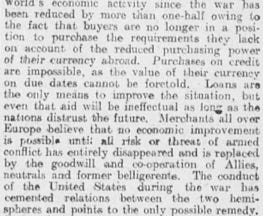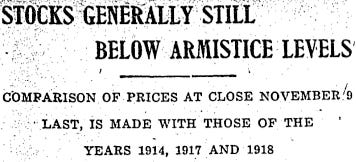November 14-20, 1921
This week, Wall Street analysts look ahead to 1922 and predict a not-so Roaring 20s, and Weimar Germany enters hyperinflation.
Quick Stats:
DJIA: 77.07 (Today: 36,100)
Shiller PE Ratio: 5.8 (Today: 39.5)
Federal Reserve Bank of NY Discount Rate: 4.5% (Today: 0.25%)
GBPUSD: $3.99 (Today: $1.34)
Price of The Wall Street Journal: $0.07 (Today: $4.00)
Market-Moving Themes:
Sentiment slowly turning positive as business activity improves and financial conditions ease; high taxes still an issue (equity, debt markets)
Wartime raw material shortages are ending, paving way for price stability (commodity markets)
European post-war debt payments are causing a strong dollar as gold flows to the United States (currency markets)
Executive Summary:
The general consensus heading into 1922 is one of soft growth and flat markets. Just two months prior, even Treasury Secretary Andrew Mellon recommended high quality bonds. Analysts this week present their top views on markets, and all of them are negative. At issue are three unresolved issues: (1) curtailed purchasing power of agricultural regions, (2) high taxes, and (3) muted foreign trade. These analysts wrangle over the decidedly improving domestic business outlook, but can’t make a case for stocks.
Historical Fact: Again and again, market forecasters, soothsayers, pundits, and Santa Claus get it wrong. In 1922, the Dow will surge 25%! Coming out of 2008, the narrative was lower returns for years. In 2015, private equity titan Leon Black famously said to sell everything “not nailed down.” These conclusions were incorrect. Entering 2021, the consensus estimate for the Dow was 32,000 (4,200 on the S&P 500), according to Refinitiv. Today, the Dow sits at 36,000 and the S&P 500 sits at 4,700.
Historical Fact 2: The major central banks (Japan, Europe, UK, US) have actively encouraged 100% equity portfolios under quantitative easing. Over the past decade, the S&P 500 and FTSE All World have returned 16% and 12% per annum, respectively. The biggest risk is what becomes familiar becomes normal and we spiral into a speculative nightmare similar to 1927-1929. The ghosts of 2008, while fading, still linger.
The FT provides a recap of 1918 to present. Coming out of the World War, the media was gripped with fears of economic depression. An economic adjustment would be sharp and vicious, experts said. The opposite happened. Artificially low financing rates juiced Western economies. When speculation ran rampant in 1919, central bankers hiked rates to prevent overheating. This pushed the world into a severe contraction. Over the past year, according to the FT, European solidarity has evaporated and private banks have stopped lending. To get out of this slump, both issues will need to be resolved.
The WSJ takes a different path and reviews stock prices from the past several years. Its conclusion? Nearly all stock prices are below Armistice levels. Judging from the apathy at the end of 1921, the paper concludes prices are appealing. Of the 100 stocks featured, only consumer staples, such as Nabisco (today known as Mondelez), are trading higher from 1918 to 1921.
Opinion prevails that recent declines in German marks are due to artificial manipulation of exchanges by Germany in order to sway sentiment in favor of reduction or cancellation of reparation payments. Recent Reichsbank statements show incredible money printing: a doubling of money supply in 4 months. The mark/USD pair has slid from 150 marks per dollar to 330 marks per dollar over the past month. Folks on the ground don’t hesitate to convert funny money into equities and hard goods.
Historical Fact: Some readers may have a pressing question: What happens to debt, including mortgages, under hyperinflation? In finance, there is a popular quote, “there is no free lunch.” By 1924, Weimar Germany will redenominate and reinstate debt into the brand new Rentenmark after bailing out Deutsche Bank and Commerzbank. It’s a messy process and beyond the scope of this publication you’re reading.
Reading this newsletter is free. If you enjoy it, then please share to a friend or donate via PayPal (button below). You may also follow us on Twitter.







